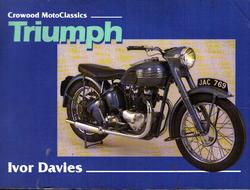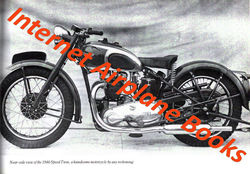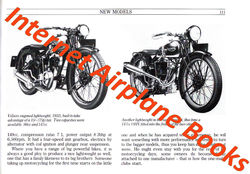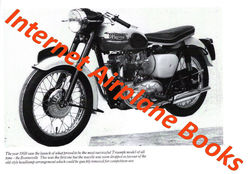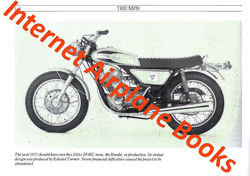TRIUMPH MOTORCYCLES BETTMANN SPEED
TWIN WW2 TURNER SINGLES TRIPLES 650 & 750 OIF ENGINE
CROWOOD MOTORCLASSICS SOFTBOUND BOOK by IVOR DAVIES
PRE-UNIT TWINS (3T / 5T / TR5 / T100 / T100C / 6T / T110
/ TR6 and T120)
THE UNIT 350 AND 500 TWINS (“THE TWENTY-ONE” / 3TA / 5TA
/ T100SS / T90 / T100 / T100T / T100S / T100R / T100C / TR5T)
650 UNIT TWINS, PRE OIL-IN-FRAME (1963 – 1970) 6T / TR6 /
T120
250 SINGLES TR25W / T25SS / T25T
T150 / T150V / X75 / T160 TRIPLES
650 and 750 OIL-IN-FRAME TWINS (1971-1988, T120 / TR6 /
T140V / TR7RV / T140E / T140D / T140ES / TR65 / TR7T / TR6T / TSS / TSX)
-----------------------------------------------------------------------------------
Additional Information from Internet Encyclopedia
The company was started by Siegfried Bettmann, who had
emigrated from Nuremberg, part of the German Empire, to Coventry in England in
1893.[2] In 1884, aged 20, Bettmann had founded his own company, the S.
Bettmann & Co. Import Export Agency, in London. Bettmann's original
products were bicycles, which the company bought and then sold under its own
name. Bettmann also distributed sewing machines imported from Germany.
In 1886, Bettmann sought a more specific name, and the
company became known as the Triumph Cycle Company. A year later, the company
was registered as the New Triumph Co. Ltd,[1] now with funding from the Dunlop
Pneumatic Tyre Company. During that year, another native of Nuremberg, Moritz
Schulte, joined the company as a partner.
Schulte encouraged Bettmann to transform Triumph into a
manufacturing company, and in 1888 Bettmann purchased a site in Coventry using
money lent by his and Schulte's families. The company began producing the first
Triumph-branded bicycles in 1889. In 1896 Triumph also opened a bicycle factory
in Nuremberg.
In 1898 Triumph decided to extend production at Coventry
to include motorcycles, and by 1902 the company had produced its first
motorcycle—a bicycle fitted with a Belgian Minerva engine.[3] In 1903, after
selling more than 500 motorcycles, Triumph began motorcycle production at the
Nuremberg factory. During the first few years the company based its designs on
those of other manufacturers, but in 1904 Triumph began building motorcycles
based on its own designs, and 1905 saw the first entirely in-house designed
motorcycle. By the end of that year, the company had produced more than 250.
In 1907, after the company opened a larger plant, it
produced 1,000 machines. Triumph had also initiated a lower-end brand, Gloria,
also manufactured in the company's original plant.
Confusion between motorcycles produced by the Coventry
and Nuremberg Triumph companies resulted in the latter's products being renamed
Orial for certain export markets. However, a company named Orial already
existed in France, so the Nuremberg motorcycles were renamed again as
"TWN", standing for Triumph Werke Nürnberg
The beginning of the First World War was a boost for the
company as production was switched to provide for the Allied war effort. More
than 30,000 motorcycles—among them the Model H Roadster also known as the
"Trusty Triumph", often cited as the first modern motorcycle—were
supplied to the Allies.
After the war, Bettmann and Schulte disagreed about
planning, with Schulte wishing to replace bicycle production with cars. Schulte
ended his association with the company, but during the 1920s Triumph purchased
the former Hillman company car factory in Coventry and produced a saloon car in
1923 under the name of the Triumph Motor Company. Harry Ricardo produced an
engine for their latest motorbike.
By the mid-1920s Triumph had become one of Britain's main
motorcycle and car makers, with a 500,000 square feet (46,000 m2) plant capable
of producing as many as 30,000 motorcycles and cars each year. Triumph also
found its bicycles demanded overseas, and export sales became a primary source
of the company's revenues, although for the United States, Triumph models were
manufactured by licence. The company's first automotive success was the Super
Seven model, which debuted in 1928. Soon after, the Super Eight model was
developed.
When the Great Depression began in 1929, Triumph sold its
German subsidiary as a separate, independently owned company, which later
merged with the Adler company to become Triumph-Adler Company. The Nuremberg
company continued to manufacture motorcycles as TWN (Triumph Werke Nürnberg)
until 1957. In 1932, Triumph sold another part of the company, its bicycle
manufacturing facility to Raleigh Bicycle Company. By then, Triumph had been
struggling financially, and Bettmann had been forced out of the job of
chairman. He retired completely in 1933.
In 1936, the company's two components became separate
companies. Triumph always struggled to make a profit from cars, and after
becoming bankrupt in 1939 was acquired by the Standard Motor Company. The
motorcycle operations fared better, having been acquired in 1936 by Jack
Sangster, who also owned the rival Ariel motorcycle company. That same year,
the company began its first exports to the United States, which quickly grew
into the company's single most important market. Sangster formed the Triumph
Engineering Co Ltd. largely directed by ex-Ariel employees, including Edward
Turner who designed the 500 cc 5T Triumph Speed Twin—released in September
1937, and the basis for all Triumph twins until the 1980s.[citation needed]
Contrary to popular belief, however, this was not Triumph's first parallel
twin. The first was the Val Page designed model 6/1, introduced in 1933. This
first twin performed well as a racer but was ultimately unpopular with the
public and did not sell well.[5] After Turner arrived, with his usual brusque
manner, the 6/1 ended, later to be replaced with Turner's design. The 6/1
engine was later reused, somewhat modified, as the BSA A10. In 1939, the 500 cc
Tiger T100, capable of 100 miles per hour (160 km/h), was released, and then
the war began.
Motorcycles were produced at Coventry until the Second
World War. The city of Coventry was virtually destroyed in the Coventry Blitz
(7 September 1940 to May 1941). Tooling and machinery was recovered from the
site of the devastation and production restarted at the new plant at Meriden,
Warwickshire in 1942.
The Triumph Speed Twin designed by Edward Turner before
the war was produced in large numbers after the war. Efforts to settle the
Lend-Lease debts caused nearly 70% of Triumph's post-war production to be
shipped to the United States. Post war, the Speed Twin and Triumph Tiger 100
were available with a sprung rear hub, Triumph's first attempt at a rear
suspension.
Privateers put wartime surplus aluminium alloy barrels on
their Tiger 100 racers, and won races, inspiring the Triumph GP model. By 1950
the supply of barrels was exhausted, and the GP model was ended. The American
market applied considerable demand to reverse this action, and a die-cast close
finned aluminium alloy barrel was made available. The aluminium alloy head made
the valve noise more obvious, so ramp type cams were introduced for aluminium
alloy head models to reduce the noise.
Another motorcycle based on the wartime generator engine
was the 498 cc TR5 Trophy Twin, also introduced at the 1948 Motor Cycle Show.
It used a single carburettor, low compression version of the Grand Prix engine.
Britain won the prestigious 1948 International Six Days Trial. The Triumph
works team had finished unpenalised. One team member, Allan Jefferies, had been
riding what amounted to a prototype version.[6]
To satisfy the American demand for motorcycles suited to
long distance riding, Turner built a 650 cc version of the Speed Twin design.
The new bike was named the Thunderbird (a name Triumph would later license to
the Ford Motor Company for use for a car model). Only one year after the
Thunderbird was introduced, a motorcyclist in Southern California mated the 650
Thunderbird with a twin carb head intended originally for GP racing and named
the new creation the Wonderbird. That 650 cc motor, designed in 1939, had the
world's absolute speed record for motorcycles from 1955 until 1970.
The Triumph brand received considerable publicity in the
United States when Marlon Brando rode a 1950 Thunderbird 6T in the 1953 film,
The Wild One.
The Triumph Motorcycle concern was sold to their rivals
BSA by Sangster in 1951. This sale included Sangster becoming a member of the
BSA board. Sangster was to become Chairman of the BSA Group in 1956.
The production 650 cc Thunderbird (6T) was a
low-compression tourer, and the 500 cc Tiger 100 was the performance
motorcycle. That changed in 1954, with the change to swing arm frames, and the
release of the aluminium alloy head 650 cc Tiger 110, eclipsing the 500 cc
Tiger 100 as the performance model.
In 1959, the T120, a tuned double carburettor version of
the Triumph Tiger T110, came to be known as the Bonneville. As Triumph and
other marques gained market share, Harley became aware that their 1-litre-plus
motorcycles were not as sporty as modern riders would like, resulting in a
decreasing share of the market. The Triumphs were models for a new,
"small" Harley-Davidson as a result: the now-fabled Harley-Davidson
Sportster, which started as Harley's version of a Triumph Bonneville. With its
anachronistic V-twin, the Sportster was no match for the Bonneville, but it
proved a solid competitor in US sales and eventually also in longevity.
During the 1960s, despite internal opposition from those
who believed that it would reduce the macho image of the brand, Triumph
produced two scooters; the Triumph Tina, a small and low-performance 2-stroke
scooter of about 100 cc with automatic clutch and a handlebar carry basket, and
the Triumph Tigress, a more powerful scooter available with either a 175 cc
2-stroke single or a 250 cc 4-stroke twin engine for the enthusiast.
In 1962, the last year of the "pre-unit"
models, Triumph used a frame with twin front down-tubes, but returned to a
traditional Triumph single front downtube for the unit construction models that
ensued. The twin down tube, or duplex frame, was used for the 650 twins, as a
result of frame fractures on the Bonneville. Introduced in 1959, for the 1960
model year, it soon needed strengthening, and was ended in 1962, with the
advent of the unit engines for the 650 range. The 3TA (21) was the first unit
construction twin, soon followed by the short-stroke, 490 cc "500"
range.
From 1963 all Triumph engines were of unit construction.
In 1969 Malcolm Uphill, riding a Bonneville, won the Isle
of Man Production TT race with a race average of 99.99 miles per hour (160.92
km/h) per lap, and recorded the first ever more than 100 miles per hour (161
km/h) lap by a production motorcycle at 100.37 miles per hour (161.53 km/h).
For many Triumph fans, the 1969 Bonneville was the best Triumph model ever.
American sales had already maximised, in 1967. In truth,
the demand for motorcycles was increasing, but Triumph could not supply the
demand.
During the 1960s, 60% of all Triumph production was
exported, which, along with the BSA's 80% exports, made the group susceptible
to the Japanese expansion. By 1969 fully 50% of the US market for motorcycles
more than 500 cc belonged to Triumph, but technological advances at Triumph had
failed to match those of the foreign companies. Triumphs lacked electric start
mechanisms, relied on push-rods rather than overhead cams, vibrated noticeably,
often leaked oil and had antiquated electrical systems; while Japanese marques
such as Honda were building more advanced features into attractive new
motorcycles that sold for less than their British competitors. Triumph
motorcycles, as a result, were nearly obsolete even when they were new.
Further, Triumph's manufacturing processes were very labour-intensive and
largely inefficient. Also disastrous, during the early 1970s the US government
mandated that all motorcycle imports must have their gearshift and brake pedals
in the Japanese configuration, which required expensive retooling of all the
motorcycles for US sale.
Triumph and BSA were well aware of Honda's ability but
while the Japanese were only making smaller engined models, the large engine
market was considered safe. When the first Honda 750 cc four cylinder was released
for sale to the public, Triumph and BSA had trouble. Despite developing and
releasing a 3-cylinder 750 cc engined motorcycle prior to the Japanese
fours—the BSA Rocket 3/Triumph Trident—the Japanese bikes were praised in the
press for their modernity (disc brakes, 4-cylinder engines, leak-free engine
casings, etc.). The British triples outperformed the Japanese fours (top speed,
acceleration and handling) but the Japanese fours required less maintenance and
they did not leak.
The 1970 Tiger/Bonneville re-design and taller twin front
downtube oil tank frame had a mixed reception from Triumph enthusiasts at the
time, and was insufficient to win back those already riding the Japanese bikes
that had been sold since 1969—the Honda 750 Four, and the Kawasaki 500 Mach 3.
The Triumph 350 cc Bandit received pre-publicity, but its development was
quietly brought to an end. Triumph was still making motorcycles, but they no
longer looked like the motorcycles Triumph fans expected. The Trident attracted
its own market, but the Japanese motorcycles were improving more rapidly.
The parent BSA group had losses of £8.5 million in 1971,
£3 million for BSA motorcycles alone. The British government became involved.
The company was sold to Manganese Bronze Holdings, which also owned Norton,
AJS, Matchless, Francis-Barnett, James-Velocette and Villiers.
Another motorcycle based on the wartime generator engine
was the 498 cc TR5 Trophy Twin, also introduced at the 1948 Motor Cycle Show.
It used a single carburettor, low compression version of the Grand Prix engine.
Britain won the prestigious 1948 International Six Days Trial. The Triumph
works team had finished unpenalised. One team member, Allan Jefferies, had been
riding what amounted to a prototype version.
To satisfy the American demand for motorcycles suited to
long distance riding, Turner built a 650 cc version of the Speed Twin design.
The new bike was named the Thunderbird (a name Triumph would later license to
the Ford Motor Company for use for a car model). Only one year after the
Thunderbird was introduced, a motorcyclist in Southern California mated the 650
Thunderbird with a twin carb head intended originally for GP racing and named
the new creation the Wonderbird. That 650 cc motor, designed in 1939, had the
world's absolute speed record for motorcycles from 1955 until 1970.
The Triumph brand received considerable publicity in the
United States when Marlon Brando rode a 1950 Thunderbird 6T in the 1953 film,
The Wild One.
The Triumph Motorcycle concern was sold to their rivals
BSA by Sangster in 1951. This sale included Sangster becoming a member of the
BSA board. Sangster was to become Chairman of the BSA Group in 1956.
The production 650 cc Thunderbird (6T) was a
low-compression tourer, and the 500 cc Tiger 100 was the performance
motorcycle. That changed in 1954, with the change to swing arm frames, and the
release of the aluminium alloy head 650 cc Tiger 110, eclipsing the 500 cc
Tiger 100 as the performance model.
In 1959, the T120, a tuned double carburettor version of
the Triumph Tiger T110, came to be known as the Bonneville. As Triumph and
other marques gained market share, Harley became aware that their 1 litre-plus
motorcycles were not as sporty as modern riders would like, resulting in a
decreasing share of the market. The Triumphs were models for a new,
"small" Harley-Davidson as a result: the now-fabled Harley-Davidson
Sportster, which started as Harley's version of a Triumph Bonneville. With its
anachronistic V-twin, the Sportster was no match for the Bonneville, but it
proved a solid competitor in US sales and eventually also in longevity.
During the 1960s, despite internal opposition from those
who believed that it would reduce the macho image of the brand, Triumph
produced two scooters; the Triumph Tina, a small and low-performance 2-stroke
scooter of about 100 cc with automatic clutch and a handlebar carry basket, and
the Triumph Tigress, a more powerful scooter available with either a 175 cc
2-stroke single or a 250 cc 4-stroke twin engine for the enthusiast.
In 1962, the last year of the "pre-unit"
models, Triumph used a frame with twin front down-tubes, but returned to a
traditional Triumph single front downtube for the unit construction models that
ensued. The twin down tube, or duplex frame, was used for the 650 twins, as a
result of frame fractures on the Bonneville. Introduced in 1959, for the 1960
model year, it soon needed strengthening, and was ended in 1962, with the
advent of the unit engines for the 650 range. The 3TA (21) was the first unit
construction twin, soon followed by the short-stroke, 490 cc "500" range.
From 1963 all Triumph engines were of unit construction.
In 1969 Malcolm Uphill, riding a Bonneville, won the Isle
of Man Production TT race with a race average of 99.99 miles per hour (160.92
km/h) per lap, and recorded the first ever more than 100 miles per hour (161
km/h) lap by a production motorcycle at 100.37 miles per hour (161.53 km/h).
For many Triumph fans, the 1969 Bonneville was the best Triumph model ever.
American sales had already maximised, in 1967. In truth,
the demand for motorcycles was increasing, but Triumph could not supply the
demand.
During the 1960s, 60% of all Triumph production was
exported, which, along with the BSA's 80% exports, made the group susceptible
to the Japanese expansion. By 1969 fully 50% of the US market for motorcycles
more than 500 cc belonged to Triumph, but technological advances at Triumph had
failed to match those of the foreign companies. Triumphs lacked electric start
mechanisms, relied on push-rods rather than overhead cams, vibrated noticeably,
often leaked oil and had antiquated electrical systems; while Japanese marques
such as Honda were building more advanced features into attractive new
motorcycles that sold for less than their British competitors. Triumph
motorcycles, as a result, were nearly obsolete even when they were new.
Further, Triumph's manufacturing processes were very labour-intensive and
largely inefficient. Also disastrous, during the early 1970s the US government
mandated that all motorcycle imports must have their gearshift and brake pedals
in the Japanese configuration, which required expensive retooling of all the
motorcycles for US sale.
Triumph and BSA were well aware of Honda's ability but
while the Japanese were only making smaller engined models, the large engine
market was considered safe. When the first Honda 750 cc four cylinder was
released for sale to the public, Triumph and BSA had trouble. Despite
developing and releasing a 3-cylinder 750 cc engined motorcycle prior to the
Japanese fours: the BSA Rocket 3/Triumph Trident, the Japanese bikes were
praised in the press for their modernity (disc brakes, 4-cylinder engines,
leak-free engine casings, etc.). The British triples outperformed the Japanese
fours (top speed, acceleration and handling) but the Japanese fours required less
maintenance and they did not leak.
The 1970 Tiger/Bonneville re-design and taller twin front
downtube oil tank frame had a mixed reception from Triumph enthusiasts at the
time, and was insufficient to win back those already riding the Japanese bikes
that had been vended since 1969; the Honda 750 Four, and the Kawasaki 500 Mach
3. The Triumph 350 cc Bandit received pre-publicity, but its development was
quietly brought to an end. Triumph was still making motorcycles, but they no
longer looked like the motorcycles Triumph fans expected. The Trident attracted
its own market, but the Japanese motorcycles were improving more rapidly.
The parent BSA group had losses of £8.5 million in 1971,
£3 million for BSA motorcycles alone. The British government became involved.
The company was sold to Manganese Bronze Holdings, which also owned Norton,
AJS, Matchless, Francis-Barnett, James-Velocette and Villiers.



